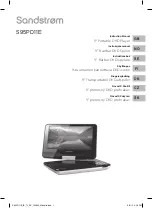
25
OPERATING INSTRUCTIONS (CONT.)
Only LINE switch engaged:
A single vertical and horizontal line intersecting at the center of
the screen.
LINE
and
7
X 11
switches engaged:
7 horizontal lines and I I vertical lines.
Only
DOT
switch engaged:
A single dot at the center of the screen.
DOT
and
7
X 11
switches engaged:
7 horizontal rows by I I vertical columns of dots.
3.
Convergence patterns use interlaced scan when the
RGB
TTL/LOW
switch is released. This causes a slight jitter
effect in the appearance of the pattern. Progressive scan may
be selected by engaging the
RGB
TTI/LOW switch for a
jitter-free pattern. Most people prefer to use progressive
scan for convergence patterns, but some newer TV sets will
not accept the signal unless interlaced scan is used.
All convergence patterns are monochrome. On most sets the
entire
7 X 11
pattern (when
7
X 11
switch is engaged) will not be
visible due to overscan: it is desirable to display a pattern of at
least 7 horizontal and 10 vertical lines or dots.
BLACK RASTER PATTERN
1.
Perform the "INITIAL SET-UP" procedure.
2.
Press the
RAST
switch. The
COLOR OFF
switch should
have no effect on the display regardless of whether it is
engaged or disengaged.
3.
The screen should not be completely black (black raster or
black-burst).
4.5 MHz SUBCARRIER USE
To check for audio isolation, the
4.5MHz
can be switched on
when the NTSC color bars pattern is selected. In a well designed
properly adjusted receiver, the sound trap should prevent the 4.5Hz
subcarrier from affecting the picture quality. In receivers where
the audio is not completely removed
from
the video component
of the signal, a "herring bone" pattern will appear on the screen.
To check the audio circuitry, the
4.5MHz
switch should be
engaged when any pattern is selected. The 4.5MHz subcarrier is
modulated by an audio tone (approximately lKHz) that can be used
to troubleshoot the audio circuitry in video equipment.
RGB OUTPUT
Independent red, green, and blue (RGB) outputs are available
for testing and adjusting color monitors that use separate red,
green, and blue inputs rather than a composite video input. Such
color monitors are often used with computers having color graphic
display capability, etc.
The Model 1249B will provide compatible test signals for most
RGB monitors using standard 525 line, 15.750KHz horizontal
Summary of Contents for 1249B
Page 1: ...INSTRUCTION MANUAL Model 1249B NTSC GENERATOR ...
Page 16: ...16 THE NTSC COLOR VIDEO SIGNAL CONT Fig 3 Elements of Color Television Signal ...
Page 20: ...20 CONTROLS AND INDICATORS CONT Fig 4 Controls and Indicators ...
Page 35: ...35 MAINTENANCE CONT R7 Fig 8 Adjustment and Test Point Locations ...
















































